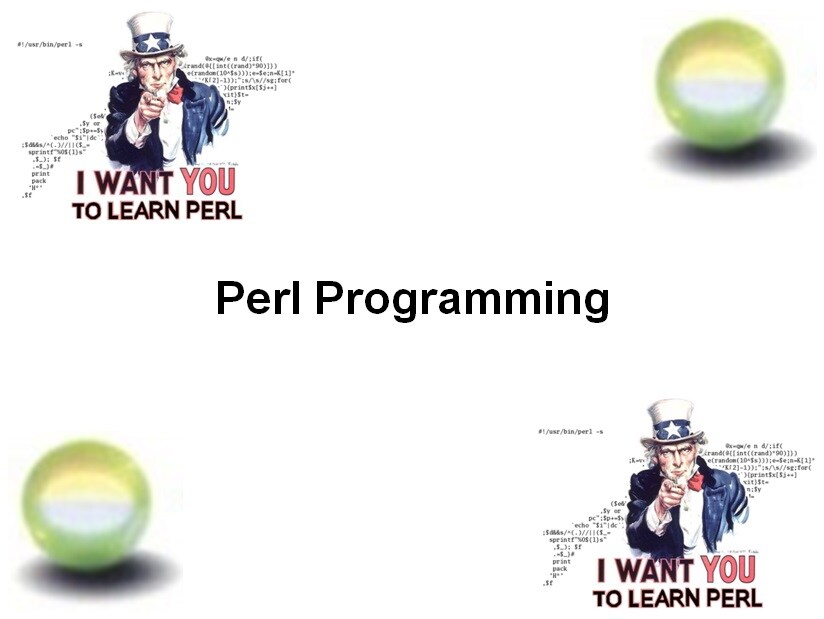- Leren door doen
- Trainers met praktijkervaring
- Klassikale trainingen
- Gedetailleerd cursusmateriaal
- Duidelijke inhoudsbeschrijving
- Maatwerk inhoud mogelijk
- Trainingen die doorgaan
- Kleine groepen
In de cursus Perl Programmeren worden de principes van de programmeertaal Perl besproken.
Na een inleiding over de kenmerken van Perl, modules en het gebruik van Perl in praktijk, wordt getoond hoe Perl scripts worden uitgevoerd.
Vervolgens wordt aandacht besteed aan de Perl syntax en het gebruik van scalar types, variabelen, operatoren en control structures. Ook Perl data structures als arrays, lists en hashes worden besproken.
De interactie tussen Perl scripts en input en output devices zoals keyboard en console is eveneens onderdeel van de cursus net als het omgaan met files en directories. In dit opzicht worden met name de diamant en de chomp operator belicht.
Vervolgens staat ook het gebruik van subroutines in Perl op het programma. Op basis van een aantal gestructureerde oefeningen leren de deelnemers hoe reguliere expressies kunnen worden gebruikt voor data validatie en het zoeken naar specifieke string patterns.
Tenslotte wordt een inleiding in object georiënteerd programmeren in Perl gegeven en er wordt besproken hoe extra Perl modules kunnen worden geïnstalleerd en gebruikt. Als voorbeeld kan gekozen worden voor verschillende Perl modules zoals modules voor Graphical User Interfaces of database access.
Het debuggen van Perl scripts met de Perl debugger wordt tussen de bedrijven door ook behandeld.
De cursus Perl Programmeren is bestemd voor systeembeheerders, webmasters en developers die willen leren programmeren in Perl of die Perl code willen begrijpen.
Kennis en ervaring met programmeren is niet strikt noodzakelijk om deel te nemen aan deze cursus, maar is wel bevorderlijk voor een goede begripsvorming.
De theorie wordt behandeld aan de hand van presentatie slides en wordt afgewisseld met oefeningen. Illustratieve demo's zorgen voor verdere verduidelijking van de begrippen. De cursus behandelt de onderwerpen van het CIW Perl examen (1D0-437). De cursustijden zijn van 9.30 tot 16.30.
De deelnemers krijgen na het goed doorlopen van de cursus een officieel certificaat Perl Programmeren.

Module 1 : Perl Introduction |
Module 2 : Scalar Types and Variables |
Module 3 : Control Flow |
| What is Perl? Perl Characteristics Hello World in Perl Typical Perl Script strict Pragma Perl Modules Installation Perl IDE's Interactive Perl Resources for Perl Usages of Perl Perl Script reading Input Perl CGI Script |
Scalar Variables Numbers and Numeric Operators Strings and String Literals String Number Conversions Scalar Variable Interpolation Reading from STDIN Comparison Operators if and while control structures Boolean Values chomp Operator undef Value and defined Function Special Scalar Variables References and dereferencing |
Conditional Statements if elsif and else unless and unless else Logical AND and OR Conditional Expression Operator given when Loop Statements while and do..while until and do..until for and foreach Jump Statements next and last redo and goto |
Module 4 : Lists and Arrays |
Module 5 : Subroutines |
Module 6 : Input and Output |
| What are Arrays and Lists? Accessing Array Elements Array Operations Special Array Indices qw Shortcut List Assignment pop, push, shift and unshift sort and reverse Interpolating Arrays into Strings foreach Control Structure Default Variable $_ Scalar and List Context Multidimensional Arrays |
Subroutines Defining a Subroutine Invoking a Subroutine Return Values Arguments Private Variables my Variables Variable-Length Parameter Lists return Operator Non Scalar Return Values State Variables More on Parameter Passing Another Subroutine Example |
Reading from STDIN Input from Diamond Operator Invocation Arguments Formatted Output Arrays and printf File Handles Reading from a File Changing Default File Handle Reading Whole File File Tests Operators Manipulate Files/Directories Listing Directories Executing External Programs |
Module 7 : Hashes |
Module 8 : Regular Expressions |
Module 9 : Perl Modules |
|
Benefits of Hashes Hash Element Access Hash as a Whole Hash Assignment More Hash Syntax Hash Element Interpolation Hash Functions More Hash Functions The %ENV Hash Counting with Hash Merging Hashes |
Simple Patterns Meta Characters Quantifiers and Character Classes Regular Expression Delimiters Subgrouping and Backreferences Regular Expression Modifiers split and join Named Captures Named Backreferences Automatic Match Variables Substitutions with s/// |
What are Perl Modules? Packages my versus our Variables Module Naming Module Namespace Creating and Using Modules Modules in Subdirectories Accessing Module Variables Exporting from Modules Importing Modules Recommended CPAN Modules |
Module 10 : Object Orientation |
||
| Object Oriented Programming Object Oriented Programming in Perl Classes and Objects Example Class and Objects Class Constructor Properties or Fields Methods and Accessors Using Objects Inheritance Inheritance with @ISA Array Overridden Methods |
